Banknotes Currently Issued
update:2024/2/8
Series-E 10,000 yen note

| Front side | A portrait of Yukichi Fukuzawa, a Meiji era philosopher and founder of Keio University. |
|---|---|
| Reverse side | A drawing of the hoo (Chinese phoenix) in the Hall of the Phoenix, Byodoin temple. |
| Size | 76mm height×160mm width |
| Date of first issue | Nov. 1, 2004 |
Interesting Information
Did you know that there are two types of 10,000 yen banknote featuring Yukichi Fukuzawa?

There are two types of banknotes carrying the portrait of Yukichi Fukuzawa; one is the Series-E 10,000 yen note that is currently being issued, and the other is the Series-D 10,000 yen note that was issued in 1984 (Showa 59).
The Series-E 10,000 yen note (figure on the right) has a hologram on the front, and an image of a Chinese phoenix on the reverse side.
The Series-D 10,000 yen note (figure on the left) does not have a hologram on the front, and has two Japanese pheasants on the reverse side.
Both series of banknotes are acceptable currency at present.
Series-E 5,000 yen note

- A.Microprinting Learn more
- B.Pearl ink Learn more
- C.Intaglio printing Learn more
- D.Hologram Learn more
- E.Tactile marks Learn more
- F.Luminescent ink Learn more
- G.Latent image Learn more
- H.Watermark Learn more
- I.Watermark-bar-pattern Learn more
| Front side | A portrait of Ichiyo Higuchi, a Meiji era writer and poet. |
|---|---|
| Reverse side | “Kakitsubata Flowers”, from a folding screen by Korin Ogata. |
| Size | 76mm height × 156mm width |
| Date of first issue | Nov. 1, 2004 |
Series-E 1,000 yen note

- A.Microprinting Learn more
- B.Pearl ink Learn more
- C.Intaglio printing Learn more
- D.Pearl pattern as latent image Learn more
- E.Tactile marks Learn more
- F.Luminescent ink Learn more
- G.Latent image (Reverse side) Learn more
- H.Watermark Learn more
- I.Watermark-bar-pattern Learn more
| Front side | A portrait of Hideyo Noguchi, a bacteriologist who devoted himself to yellow fever research. |
|---|---|
| Reverse side | A drawing of Mt. Fuji and cherry blossoms. |
| Size | 76mm height × 150mm width |
| Date of first issue | Nov. 1, 2004 |
Series-D 2,000 yen note

- A.Microprinting Learn more
- B.Pearl ink Learn more
- C.Intaglio printing Learn more
- D.Tactile marks Learn more
- E.Luminescent ink Learn more
- F.Latent image Learn more
- G.Watermark Learn more
- H.Latent image (Reverse side) Learn more
- I.Microprinting (Reverse side) Learn more
| Front side | A drawing in the pattern of Shurei Gate, the second gate of Shuri Castle in Okinawa. |
|---|---|
| Reverse side | A design in which explanatory text superimposes an image of “The Bell Cricket”, from Chapter 38 of The Tale of Genji Scroll, and a portrait of the tale's author, Murasaki Shikibu. |
| Size | 76mm height × 154mm width |
| Date of first issue | Jul. 19, 2000 |
Anti-counterfeiting measures that can be confirmed by touch
Intaglio printing
Notes are printed with ink that rises higher than the ink on older notes, giving them a textured feeling when touched.




Tactile marks
In place of watermarking, tactile marks by intaglio printing with a textured feeling are employed to help the visually handicapped distinguish different notes with their fingers.
Identifying marks are shaped differently for each type of note in order to make it easier to differentiate between the different notes.
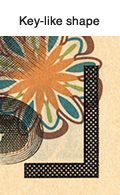
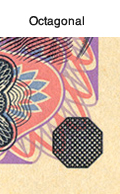
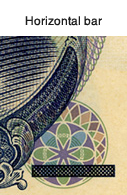
![Japanese hiragana character “に” [read as “ni”] in Braille(Series-D 2,000 yen note)](current.images/img_genzai10_04.jpg)
Anti-counterfeiting measures that can be confirmed with watermarks
Watermark
Watermarking is a technique to prevent counterfeiting by producing variations in the thickness of the paper. The watermark has sharp and spatial gradation in its image.
There are watermarks of Yukichi Fukuzawa, Ichiyo Higuchi, Hideyo Noguchi, and the Shurei Gate in Okinawa; the same portraits and landscape as the ones found on the front of the notes.
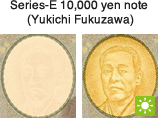
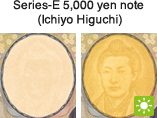
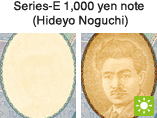
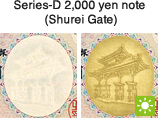
Watermark-bar-pattern
Watermarks in bar patterns are embedded in the paper. When seen against the light, the Series-E 10,000 yen note has 3 bars, the Series-E 5,000 yen note has 2 bars, and the Series-E 1,000 yen note has 1 bar.
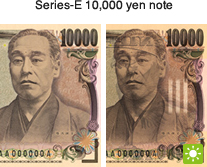
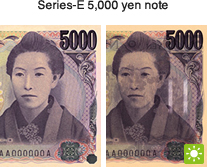
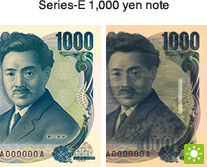
Anti-counterfeiting measures that can be confirmed by tilting
Hologram
When seen from different angles, the characters for the denomination “10000”, a design of “日” from “日本銀行” meaning the Bank of Japan, and the image of a cherry tree appear.
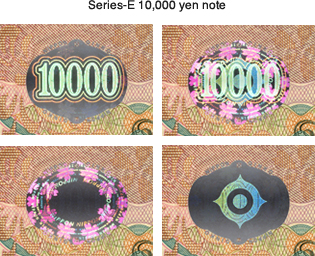
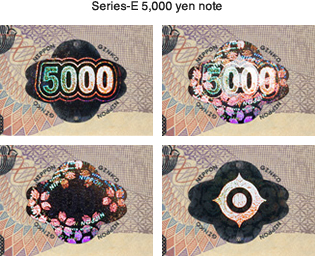
Latent images
When tilting a note, the denomination “10000”, “5000” and “2000” appears on the front side, and “NIPPON” appears on the reverse side.
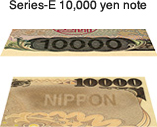
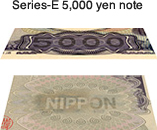
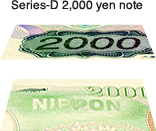
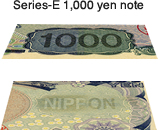
Pearl patterns as latent images
When the note is tilted, depending on the angle, the characters “千円” or the denomination “1000” produced by pearl printing appear as latent images in the bar on the bottom left of the note.

Pearl ink
Not visible from the front, but when tilting a note, a pink pattern emerges at the center of either end of the note.
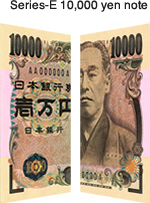
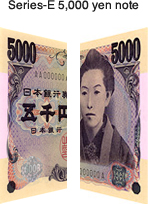
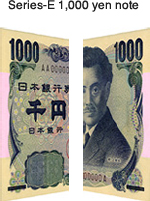
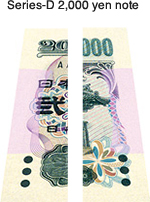
Color shifting inks
When tilting a note, the characters for “2000” change color from blue green to purple.

Anti-counterfeiting measures that can be confirmed with tools
Microprinting
“NIPPONGINKO” is printed in microscript that cannot be easily reproduced on color copy machines.
The letters can be discerned when magnified using a tool such as a loupe (magnifying glass).
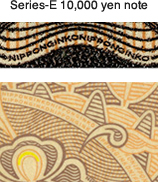
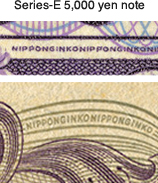
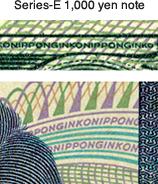
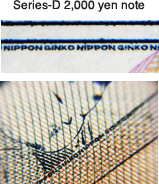
Luminescent ink
When ultraviolet light is shone on a note, the seal of the Governor of the Bank of Japan on the front side, and part of the background pattern on either side, become luminous.
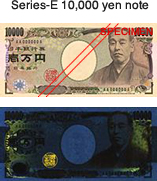
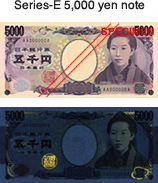
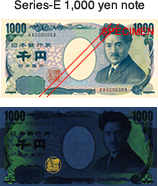
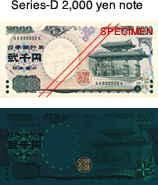
Others
Various anti-counterfeit measures are used on banknotes, including technologies that make it easy to identify counterfeit notes by sight and touch, as well as technologies that make it difficult to create counterfeit notes using computers and other such equipment. There are also technologies to enhance the counterfeit detection capabilities of cash handling machines (ATMs, vending machines, etc.).
This last technology is to prevent counterfeits that target machines such as the widely available vending machines. In order to ensure that these kinds of counterfeit attempts are identified, the banknotes incorporate measures that make it easy to check the validity of the notes in cash-handling machines.

